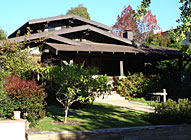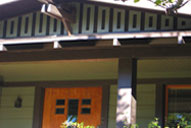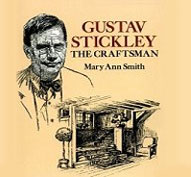




315 10th St.


Aeroplane Bungalow, 1912
photo by Michael Grandcolas

Facade detail Aeroplane Bungalow,

Gustav Stickley - the craftsman
Mining engineer DeWitt Creveling, who built and occupied 315 10th St. was praised for his fine design and execution as this structure has been said to embody some of the most desirable elements of Craftsman architecture. Enjoy the beauty of woodwork on this property, as well as the relationship of the structure to its natural surroundings.
Bungalow is a popular Southern California housing concept, but the bungalow design model comes from India. The British adopted the word and concept of the bungalow when they ruled India during the 19th century. In the vicinity of the city of Bengal, the British discovered that natives built one-story huts with thatched roofs called bangala.
The design style of the bangala was adapted and modified by the British, who blended concept with elements borrowed from the regulation army tent, the English cottage, and the Persian verandah. For their bungalows, the British arranged dining rooms, bedrooms, kitchens, and bathrooms around central living rooms. Examine the typical bungalow architectural plan. This efficient floor plan became the prototype for America's Craftsman Bungalows - a one-story, low, hip-roofed house complemented by a wide veranda or porch.
Promotional literature in the early 20th century often noted that the
chief purpose of the bungalow was to place most of the living spaces on
one floor. The economical practicality of a single story house caused
the bungalow concept to overrun North America in the late 19th and early
20th centuries.
An evolution of the bungalow was the “Airplane” or “Aeroplane”
bungalow, such as this fine example at 315 10th St. According to the book
"The Bungalow: America's Arts and Crafts Home", “Aeroplane”
or "Airplane" bungalows feature a single room on the second
story:
"[A] novel way that attic levels were incorporated into bungalow design is seen in a hybrid form known as the airplane bungalow."
"In these homes, an attic-level room was designed to project above the peak of the main roofline, making such a room similar to the raised cockpit of an early twentieth-century airplane. Set above the broad sweep of the bungalow's roofline, comparable to an airplane's wings, this upper room was often first built as a screened-in sleeping porch. "
"Later, many such spaces were enclosed to create a playroom, extra bedroom space, or a retreat. Its desirability was enhanced by the fact that it was likely to have the best view in the house, as well as the ability to catch cooling breezes from its lofty height." *
* "The Bungalow: America's Arts and Crafts Home," Paul Duchscherer
& Douglas Keister. New York: Penguin Studio, 1995, p. 31